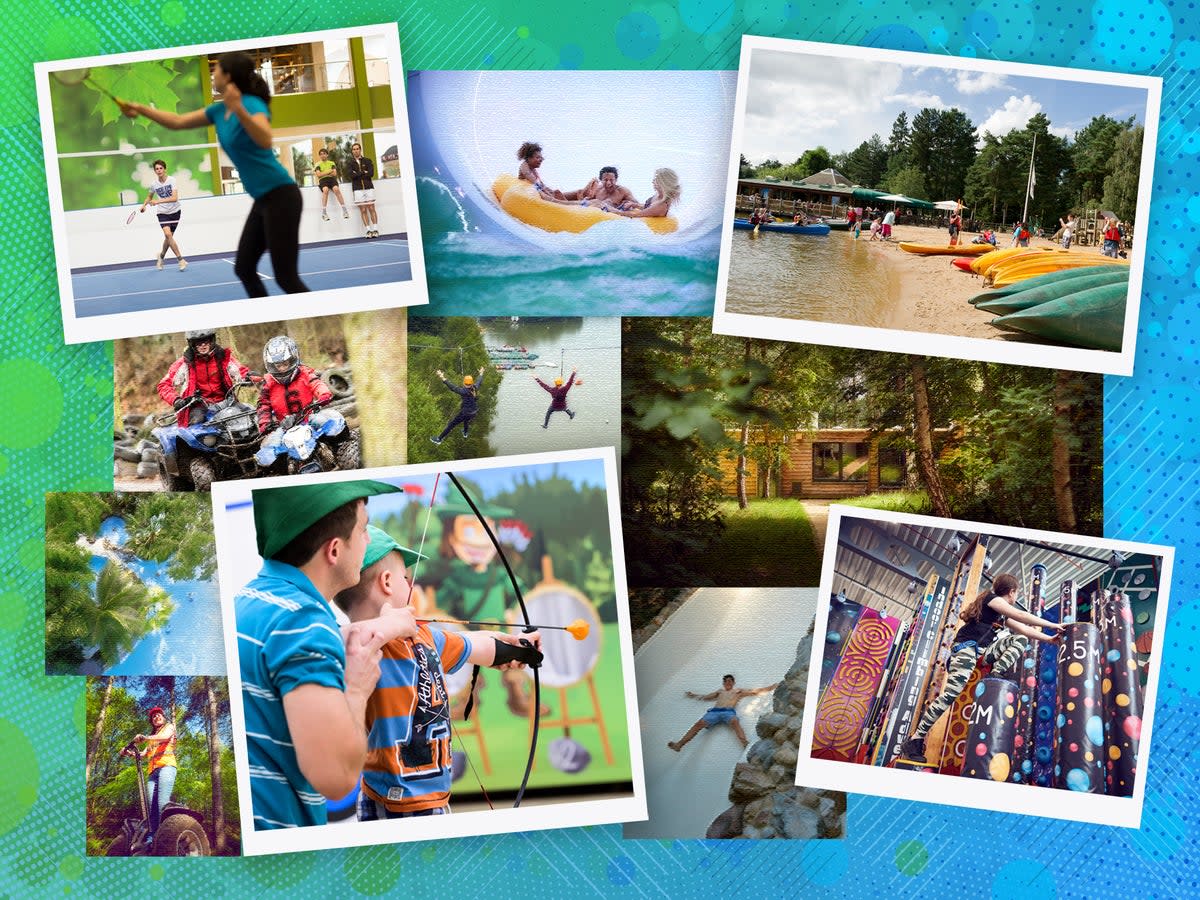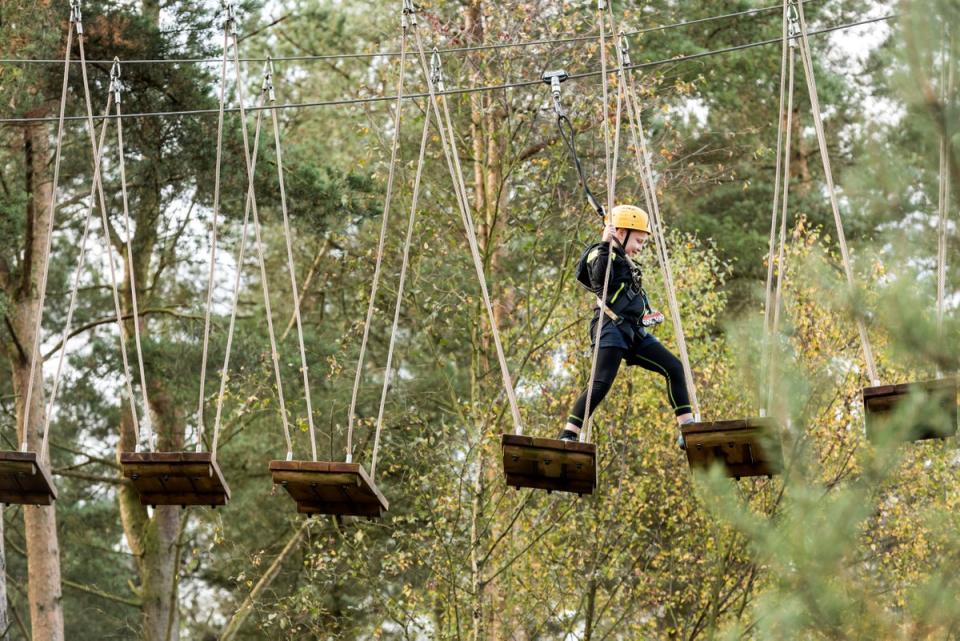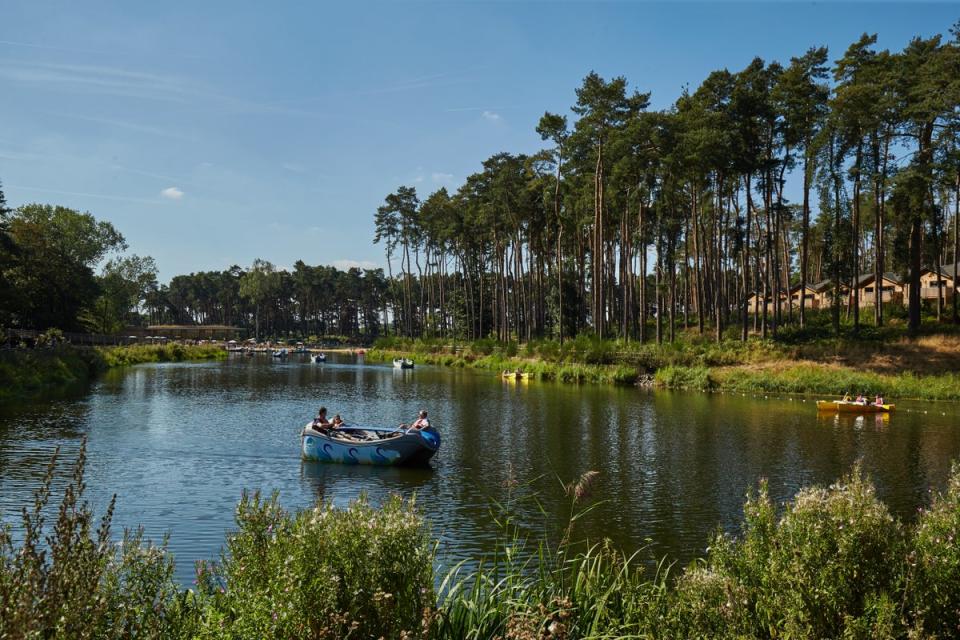Wooded utopias or expensive holiday camps? How Center Parcs divided the UK

When news broke last month that Center Parcs’ UK and Irish business was up for sale for a rumoured £5bn, the punchlines wrote themselves. “That’s almost as much as it costs to do a few activities!” “Try booking it during the school holidays!” You get the gist. More than 35 years after Sherwood Forest, the company’s inaugural UK resort, opened its gates in Nottinghamshire, ushering visitors into the Subtropical Swimming Paradise’s sci-fi geodesic dome, Center Parcs has become a very British obsession – one that’s surprisingly polarising.
Some see the brand’s short breaks as an egregious rip-off, the rates exorbitant for a brief sojourn in what they believe is essentially a holiday camp with delusions of grandeur. They have a point. A four-night stay in a two-bedroom woodland lodge in Sherwood Forest during the final week of July would set you back £1,299 at the time of writing. If you fancy a four-bedroom “new style executive lodge”, with a sauna and games room, that’d be £2,799. “For some sites, a weekend there is the cost of a self-catering holiday in the Mediterranean,” notes Beverley Boden, head of aviation, tourism, finance and marketing at Teesside University.
But for the devotees, the parcs are wooded utopias reachable by motorway, where kids can enjoy (yes, expensive) sport and craft sessions while grown-ups exhale in the Aqua Sana spa. They might reminisce about being buffeted by the wild water rapids (“I was so obsessed with them, but I also nearly drowned,” recalls The Independent’s Patrick Smith. “I got pulled under and then someone had to dive in to save me.”). Or about the time when they watched snow falling while ensconced in the warmth of the outdoor pool. They might even, like me, have fond memories of the strangely hypnotic Badgercam, the grainy 24/7 dedicated TV channel that keeps tabs on the woodland creatures of Whinfell Forest in Cumbria.
And there are certainly plenty of those fans. The six sites are visited by more than 2 million guests annually; more than half of them will return over the next five years. In 2022, the villages had a 97.3 per cent occupancy rate, a return to pre-pandemic levels. It’s this enduring success – plus the Covid-induced boom in domestic tourism – that may have encouraged its present owners, Canadian private equity group Brookfield Property, to put the business up for sale for around double what they originally paid for it back in 2015. “Providing nature and tranquillity for a week or weekend that caters for families is a strong business proposition,” Boden says.
Even its cheerleaders, though, surely wouldn’t dispute that over the years, Center Parcs has become a byword for all things middle class. The brand “carries a lot more cultural capital than other staycation options”, explains Alex Strang of consumer insights agency Canvas8. He describes a trip there as “almost a social signifier of status… a symbol [of] stability and social position”. The prices are undeniably geared towards “high earners and customers with a high disposable income”, as Boden puts it, for whom a Center Parcs trip probably won’t even be their main holiday of the year. And then there are the activities. An archery session in the home of Robin Hood costs £28.50 each (which might give Robin, that famous fan of wealth distribution, pause). Watersports tuition starts at £29 for an hour. Den building will set you back £48 per plot. (It is, of course, possible to do things less extravagantly on arrival, by bringing your own food and scaling back the add-ons.)
But the business didn’t start out like this. Back in the Sixties, Dutch businessman and devout Catholic Piet Derksen founded a holiday resort near the village of Reuver, about 40 miles from Eindhoven and close to the German border, where employees and customers of his sportswear business, Sporthuis Centrum, could spend their summers. First, they could rent tents, then, when the scheme proved popular, these were replaced by bungalows. “You can see the idea of Center Parcs as an evolution of the [tradition of] wholesome, sometimes Christian summer camps in Europe,” says architect Tim O’Callaghan of London-based architects nimtim; back in 2005, his post-graduate dissertation explored the resorts’ architecture.
Derksen hired the architect Jaap Bakema to work on the blueprint for the first Sporthuis Centrum village. He was, O’Callaghan explains, “the senior figure of a group of architects called Team 10”, whose work offered “an evolution of modernism”, and many of his projects were “socially minded”. After Rotterdam was heavily bombed during the Second World War, Bakema pioneered the city’s pedestrianised shopping street and designed its public library.

He also thought at length about how buildings and people interacted with nature; his vision, O’Callaghan says, was more ecologically aware than many of his contemporaries. In his Center Parcs designs, he tried to immerse guests in the landscape, placing the single-storey cabins below the line of the trees.
In the Eighties, Bakema introduced the first domed swimming pool, Aqua Mundo, at the De Eemhof village near Amsterdam; with its palm trees, balmy 29.5C temperatures and wild water rapids, it set a template that Center Parcs has retained to this day. With the leisure industry undergoing a “huge shift” in that decade that, according to Dr Donna Poade, tourism lecturer at Falmouth University’s Cornwall Business School, placed a new focus on health and fitness, it seemed like the right time to bring the holiday concept to the UK.

When John Stubbings, who worked on the original UK ad campaign for Sherwood Forest’s 1987 launch, was invited to visit one of Center Parcs’ Dutch sites to get a better understanding of what they’d be selling, he and his colleagues were “a bit snippy”, he recalls – “we’re ad agency types. But after about 15 minutes [in the pool], you’re having an amazing time … We realised, ‘they’ve got something here.’” That “something” was weatherproof – the sci-fi swimming dome felt tropical whatever the weather – cue visions of “a 365-days-a-year holiday”.
The Brits thought that Center Parcs had an upmarket potential that the Dutch were underselling; they also decided to “distance” the brand from the visions of a more traditional holiday camp, because “the reference point became Butlins slash Hi-De-Hi!”. There was “quite a lot of friction”, Stubbings remembers, “between the British team and the Dutch originators, who saw it as very much an egalitarian holiday, but we [thought] ‘you’re pitching it too downmarket’”. (The Dutch team, he says, were also surprised when they suggested that it might be necessary to add locks to the rental bikes.)
I was so obsessed with them, but I also nearly drowned... I got pulled under and then someone had to dive in to save me
Patrick Smith, The Independent
Early focus groups got a bit confused over the Subtropical Swimming Paradise. After watching an early version of the TV ad, they “thought the whole thing was under a dome”, like a Truman Show prototype, Stubbings explains. With a John Hurt voiceover asking British tourists to “abandon all preconceptions” of UK holidays, the finished clip was a hit – it “pioneered the concept of an all-year-round short break in the UK”, Dr Poade says.
What’s fascinating is how easily this Dutch vision of egalitarianism chimed with British middle-class ideals. Resorts like Butlins, O’Callaghan says, were “very much an echo of working-class British cities, with terraces and organised entertainment” – but while Center Parcs “came from Holland, where class is less pervasive, it slotted in quite nicely with the British middle-class liberal mentality – you choose what you do, when you want, you’ve got a reasonable level of separation from neighbours. It obviously evolved in a slightly different culture but managed to fit in quite well.”

The prices made a Center Parcs trip a status symbol – but so did the offer of experiences that were hard to come across elsewhere. “It [was] obviously a middle-class holiday,” Stubbings says, “but it brought to the middle classes things that were actually quite difficult to get – the spa was pretty remarkable when that first one opened in ’87, unless you were the type that actually went to a health farm … That was a joyous thing about it – people trying things for the first time … They created this very safe world where people could try things, they could push their own limits.”
Safe is a word that comes up a lot when attempting to unpick the appeal of Center Parcs. The car ban means that kids have free rein – for many younger visitors, it’s the first time they get a taste of independence. “I’d been going since I was a toddler but from the age of me being about eight or nine, my parents allowed me and my mates to go cycling around the site without constant supervision,” Smith says. “There was no fear, as there was in London, of us being knocked off our bikes.”

It’s a break that offers comfortable respite from urban life, with the muddy, potentially perilous parts of nature excised. Strang calls this “the paradox of Center Parcs”: you’re ostensibly immersed in the natural world, but it’s a sheltered, slightly artificial version (and that might even be part of the appeal). “It is billed as a woodland escape, where people can lose themselves in the forest – but in reality, it’s a lot safer than that … It’s a way to get the illusion of getting away from it all and being off-grid, while actually still feeling incredibly safe and secure,” he adds.
Sometimes, though, even well-behaved animals go (benignly) rogue. Charlie Rosse, aka The Roaming Reader, recalls one memorable morning after the night before on a visit to the Longleat Forest resort in Wiltshire; she and her friends had forgotten to close the patio doors after a few drinks. “I stepped out of my room to use the bathroom and came face to face with two little deer… one nibbling at the remnants of our party in the living room,” she says. “And there was a third on the veranda, too timid to come in. They’d clearly wandered inside other cabins before and knew there would be food.”
Center Parcs is, I think, a bit of a tourist industry Rorschach test: enter one of the parcs and you will probably see your own biases projected back at you. It’s seen as a bit uppity, but it’s also the subject of snobbery. And easy as it may be to mock, the company is still laughing all the way to the bank. Quick spin around the rapids, anyone?


